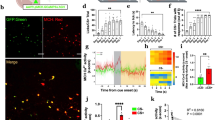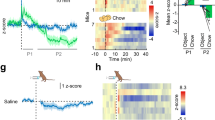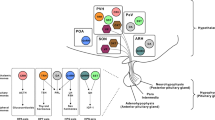Abstract
Objective:
The hypothalamic control of energy balance is regulated by a complex network of neuropeptide-releasing neurons. Although the effect of these neuropeptides on individual aspects of energy homoeostasis has been studied, the coordinated response of these effects has not been comprehensively investigated. We have simultaneously monitored a number of metabolic parameters following intracerebroventricular (ICV) administration of 1 and 3 nmol of neuropeptides with established roles in the regulation of feeding, activity and metabolism. Ad libitum- fed rats received the orexigenic neuropeptides neuropeptide Y (NPY), agouti-related protein (AgRP), melanin-concentrating hormone (MCH) or orexin-A. Overnight-food-deprived rats received an ICV injection of the anorectic peptides α-melanocyte-stimulating hormone (MSH), corticotrophin-releasing factor (CRF) or neuromedin U (NMU).
Results:
Our results reveal the temporal sequence of the effects of these neuropeptides on both energy intake and expenditure, highlighting key differences in their function as mediators of energy balance. NPY and AgRP increased feeding and decreased oxygen consumption, with the effects of AgRP being more prolonged. In contrast, orexin-A increased both feeding and oxygen consumption, consistent with an observed increase in activity. The potent anorexigenic effects of CRF were accompanied by a prolonged increase in activity, whereas NMU injection resulted in significant but short-lasting inhibition of food intake, ambulatory activity and oxygen consumption. α-MSH injection resulted in significant increases in both ambulatory activity and oxygen consumption, and reduced food intake following administration of 3 nmol of the peptide.
Conclusion:
We have for the first time, simultaneously measured several metabolic parameters following hypothalamic administration of a number of neuropeptides within the same experimental system. This work has shown the interrelated effects of these neuropeotides on activity, energy expenditure and food intake, thus facilitating comparison between the different hypothalamic systems.
This is a preview of subscription content, access via your institution
Access options
Subscribe to this journal
Receive 12 print issues and online access
$259.00 per year
only $21.58 per issue
Buy this article
- Purchase on Springer Link
- Instant access to full article PDF
Prices may be subject to local taxes which are calculated during checkout





Similar content being viewed by others
References
Broberger C, Visser TJ, Kuhar MJ, Hokfelt T . Neuropeptide Y innervation and neuropeptide-Y-Y1-receptor-expressing neurons in the paraventricular hypothalamic nucleus of the mouse. Neuroendocrinology 1999; 70: 295–305.
Sakurai T, Amemiya A, Ishii M, Matsuzaki I, Chemelli RM, Tanaka H et al. Orexins and orexin receptors: a family of hypothalamic neuropeptides and G protein-coupled receptors that regulate feeding behavior. Cell 1998; 92: 1.
Vaughan JM, Fischer WH, Hoeger C, Rivier J, Vale W . Characterization of melanin-concentrating hormone from rat hypothalamus. Endocrinology 1989; 125: 1660–1665.
Hashimoto K, Ohno N, Aoki Y, Kageyama J, Takahara J, Ofuji T . Distribution and characterization of corticotropin-releasing factor and arginine vasopressin in rat hypothalamic nuclei. Neuroendocrinology 1982; 34: 32–37.
Howard AD, Wang R, Pong SS, Mellin TN, Strack A, Guan XM et al. Identification of receptors for neuromedin U and its role in feeding. Nature 2000; 406: 70–74.
Edwards CM, Abusnana S, Sunter D, Murphy KG, Ghatei MA, Bloom SR . The effect of the orexins on food intake: comparison with neuropeptide Y, melanin-concentrating hormone and galanin. J Endocrinol 1999; 160: R7–12.
Smith KL, Patterson M, Dhillo WS, Patel SR, Semjonous NM, Gardiner JV et al. Neuropeptide S stimulates the hypothalamo-pituitary-adrenal axis and inhibits food intake. Endocrinology 2006; 147: 3510–3518.
Blaxter KL . Energy Metabolism in Animals and Man. CUP Archive, Chapter 8. The Minimal Metabolism, 1989, pp120–145.
Rossi M, Kim MS, Morgan DG, Small CJ, Edwards CM, Sunter D et al. A C-terminal fragment of agouti-related protein increases feeding and antagonizes the effect of alpha-melanocyte stimulating hormone in vivo. Endocrinology 1998; 139: 4428–4431.
Abbott CR, Rossi M, Kim M, AlAhmed SH, Taylor GM, Ghatei MA et al. Investigation of the melanocyte stimulating hormones on food intake. Lack of evidence to support a role for the melanocortin-3-receptor. Brain Res 2000; 869: 203–210.
Negri L, Noviello L, Noviello V . Effects of sauvagine, urotensin I and CRF on food intake in rats. Peptides 1985; 6 (Suppl 3): 53–57.
Rossi M, Choi SJ, O'Shea D, Miyoshi T, Ghatei MA, Bloom SR . Melanin-concentrating hormone acutely stimulates feeding, but chronic administration has no effect on body weight. Endocrinology 1997; 138: 351–355.
Le Magnen J, Tallon S . [The spontaneous periodicity of ad libitum food intake in white rats]. J Physiol (Paris) 1966; 58/3: 323–349.
Le Magnen J . Peripheral and systemic actions of food in the caloric regulation of intake. Ann NY Acad Sci 1969; 157: 1126–1157.
Strubbe JH, Spiteri NJ, Alingh Prins AJ . Effect of skeleton photoperiod and food availability on the circadian pattern of feeding and drinking in rats. Physiol Behav 1986; 36: 647–651.
Spiteri NJ, Prins AA, Keyser J, Strubbe JH . Circadian pacemaker control of feeding in the rat, at dawn. Physiol Behav 1982; 29: 1141–1145.
Kim MS, Rossi M, Abusnana S, Sunter D, Morgan DG, Small CJ et al. Hypothalamic localization of the feeding effect of agouti-related peptide and alpha-melanocyte-stimulating hormone. Diabetes 2000; 49: 177–182.
Abbott CR, Kennedy AR, Wren AM, Rossi M, Murphy KG, Seal LJ et al. Identification of hypothalamic nuclei involved in the orexigenic effect of melanin-concentrating hormone. Endocrinology 2003; 144: 3943–3949.
Lawrence CB, Liu YL, Stock MJ, Luckman SM . Anorectic actions of prolactin-releasing peptide are mediated by corticotropin-releasing hormone receptors. Am J Physiol Regul Integr Comp Physiol 2004; 286: R101–R107.
Wirth MM, Giraudo SQ . Agouti-related protein in the hypothalamic paraventricular nucleus: effect on feeding. Peptides 2000; 21: 1369–1375.
Clark JT, Kalra PS, Crowley WR, Kalra SP . Neuropeptide Y and human pancreatic polypeptide stimulate feeding behavior in rats. Endocrinology 1984; 115: 427–429.
Ollmann MM, Wilson BD, Yang YK, Kerns JA, Chen Y, Gantz I et al. Antagonism of central melanocortin receptors in vitro and in vivo by agouti-related protein. Science 1997; 278: 135–138.
Qu D, Ludwig DS, Gammeltoft S, Piper M, Pelleymounter MA, Cullen MJ et al. A role for melanin-concentrating hormone in the central regulation of feeding behaviour. Nature 1996; 380: 243–247.
Goldstone AP, Unmehopa UA, Bloom SR, Swaab DF . Hypothalamic NPY and agouti-related protein are increased in human illness but not in Prader-Willi syndrome and other obese subjects. J Clin Endocrinol Metab 2002; 87: 927–937.
Billington CJ, Briggs JE, Grace M, Levine AS . Effects of intracerebroventricular injection of neuropeptide Y on energy metabolism. Am J Physiol 1991; 260 (Part 2): R321–R327.
Egawa M, Yoshimatsu H, Bray GA . Neuropeptide Y suppresses sympathetic activity to interscapular brown adipose tissue in rats. Am J Physiol 1991; 260 (Part 2): R328–R334.
Fekete C, Kelly J, Mihaly E, Sarkar S, Rand WM, Legradi G et al. Neuropeptide Y has a central inhibitory action on the hypothalamic-pituitary-thyroid axis. Endocrinology 2001; 142: 2606–2613.
Schuhler S, Warner A, Finney N, Bennett GW, Ebling FJ, Brameld JM . Thyrotrophin-releasing hormone decreases feeding and increases body temperature, activity and oxygen consumption in Siberian hamsters. J Neuroendocrinol 2007; 19: 239–249.
Griffiths EC, Rothwell NJ, Stock MJ . Thermogenic effects of thyrotrophin-releasing hormone and its analogues in the rat. Experientia 1988; 44: 40–42.
Hagan JJ, Leslie RA, Patel S, Evans ML, Wattam TA, Holmes S et al. Orexin A activates locus coeruleus cell firing and increases arousal in the rat. Proc Natl Acad Sci USA 1999; 96: 10911–10916.
Monda M, Viggiano A, Viggiano A, Viggiano E, Messina G, Tafuri D et al. Sympathetic and hyperthermic reactions by orexin A: role of cerebral catecholaminergic neurons. Regul Pept 2007; 139: 39–44.
Morley JE, Levine AS . Corticotrophin releasing factor, grooming and ingestive behavior. Life Sci 1982; 31: 1459–1464.
Dunn AJ, Berridge CW, Lai YI, Yachabach TL . CRF-induced excessive grooming behavior in rats and mice. Peptides 1987; 8: 841–844.
de GL, Penalva RG, Flachskamm C, Reul JM, Linthorst AC . Differential monoaminergic, neuroendocrine and behavioural responses after central administration of corticotropin-releasing factor receptor type 1 and type 2 agonists. J Neurochem 2005; 94: 45–56.
Linthorst AC, Penalva RG, Flachskamm C, Holsboer F, Reul JM . Forced swim stress activates rat hippocampal serotonergic neurotransmission involving a corticotropin-releasing hormone receptor-dependent mechanism. Eur J Neurosci 2002; 16: 2441–2452.
Egawa M, Yoshimatsu H, Bray GA . Effect of corticotropin releasing hormone and neuropeptide Y on electrophysiological activity of sympathetic nerves to interscapular brown adipose tissue. Neuroscience 1990; 34: 771–775.
Hanada R, Nakazato M, Murakami N, Sakihara S, Yoshimatsu H, Toshinai K et al. A role for neuromedin U in stress response. Biochem Biophys Res Commun 2001; 289: 225–228.
Yokota M, Ozaki Y, Sakamoto F, Yamada S, Saito J, Fujihara H et al. Fos expression in CRF-containing neurons in the rat paraventricular nucleus after central administration of neuromedin U. Stress 2004; 7: 109–112.
Hanada T, Date Y, Shimbara T, Sakihara S, Murakami N, Hayashi Y et al. Central actions of neuromedin U via corticotropin-releasing hormone. Biochem Biophys Res Commun 2003; 311: 954–958.
Wren AM, Small CJ, Abbott CR, Jethwa PH, Kennedy AR, Murphy KG et al. Hypothalamic actions of neuromedin U. Endocrinology 2002; 143: 4227–4234.
Poggioli R, Vergoni AV, Bertolini A . ACTH-(1-24) and alpha-MSH antagonize feeding behavior stimulated by kappa opiate agonists. Peptides 1986; 7: 843–848.
Fekete C, Legradi G, Mihaly E, Huang QH, Tatro JB, Rand WM et al. Alpha-melanocyte-stimulating hormone is contained in nerve terminals innervating thyrotropin-releasing hormone-synthesizing neurons in the hypothalamic paraventricular nucleus and prevents fasting-induced suppression of prothyrotropin-releasing hormone gene expression. J Neurosci 2000; 20: 1550–1558.
Kim MS, Small CJ, Stanley SA, Morgan DG, Seal LJ, Kong WM et al. The central melanocortin system affects the hypothalamo-pituitary thyroid axis and may mediate the effect of leptin. J Clin Invest 2000; 105: 1005–1011.
Harris M, Aschkenasi C, Elias CF, Chandrankunnel A, Nillni EA, Bjoorbaek C et al. Transcriptional regulation of the thyrotropin-releasing hormone gene by leptin and melanocortin signaling. J Clin Invest 2001; 107: 111–120.
Song CK, Vaughan CH, Keen-Rhinehart E, Harris RB, Richard D, Bartness TJ . Melanocortin-4 receptor mRNA expressed in sympathetic outflow neurons to brown adipose tissue: neuroanatomical and functional evidence. Am J Physiol Regul Integr Comp Physiol 2008; 295: R417–R428.
Mountjoy KG, Robbins LS, Mortrud MT, Cone RD . The cloning of a family of genes that encode the melanocortin receptors. Science 1992; 257: 1248–1251.
Huszar D, Lynch CA, Fairchild-Huntress V, Dunmore JH, Fang Q, Berkemeier LR et al. Targeted disruption of the melanocortin-4 receptor results in obesity in mice. Cell 1997; 88: 131–141.
Yeo GS, Farooqi IS, Aminian S, Halsall DJ, Stanhope RG, O'Rahilly S . A frameshift mutation in MC4R associated with dominantly inherited human obesity. Nat Genet 1998; 20: 111–112.
Chen AS, Marsh DJ, Trumbauer ME, Frazier EG, Guan XM, Yu H et al. Inactivation of the mouse melanocortin-3 receptor results in increased fat mass and reduced lean body mass. Nat Genet 2000; 26: 97–102.
Acknowledgements
This research is funded by programme grants from the MRC (G7811974) and Wellcome Trust (072643/Z/03/Z) and by an EU FP6 Integrated Project Grant LSHM-CT-2003-503041. We are also grateful for the support from the NIHR Biomedical Research Centre funding scheme and an IMB Capacity building award. The CLAMS were purchased with joint funding from the Imperial College Strategic Infrastructure Fund and the MRC. KLS and KGM both hold BBSRC New Investigator Awards. The authors also thank Linton Instrumentation (Norfolk, UK) for their assistance in the installation and maintenance of the CLAMS.
Author information
Authors and Affiliations
Corresponding author
Additional information
Supplementary Information accompanies the paper on International Journal of Obesity website (http://www.nature.com/ijo)
Supplementary information
Rights and permissions
About this article
Cite this article
Semjonous, N., Smith, K., Parkinson, J. et al. Coordinated changes in energy intake and expenditure following hypothalamic administration of neuropeptides involved in energy balance. Int J Obes 33, 775–785 (2009). https://doi.org/10.1038/ijo.2009.96
Received:
Revised:
Accepted:
Published:
Issue Date:
DOI: https://doi.org/10.1038/ijo.2009.96
Keywords
This article is cited by
-
Acts of appetite: neural circuits governing the appetitive, consummatory, and terminating phases of feeding
Nature Metabolism (2022)
-
Neuroendocrine control of appetite and metabolism
Experimental & Molecular Medicine (2021)
-
Ghrelin treatment induces rapid and delayed increments of food intake: a heuristic model to explain ghrelin’s orexigenic effects
Cellular and Molecular Life Sciences (2021)
-
Role of sex and high-fat diet in metabolic and hypothalamic disturbances in the 3xTg-AD mouse model of Alzheimer’s disease
Journal of Neuroinflammation (2020)
-
l-phenylalanine modulates gut hormone release and glucose tolerance, and suppresses food intake through the calcium-sensing receptor in rodents
International Journal of Obesity (2017)



